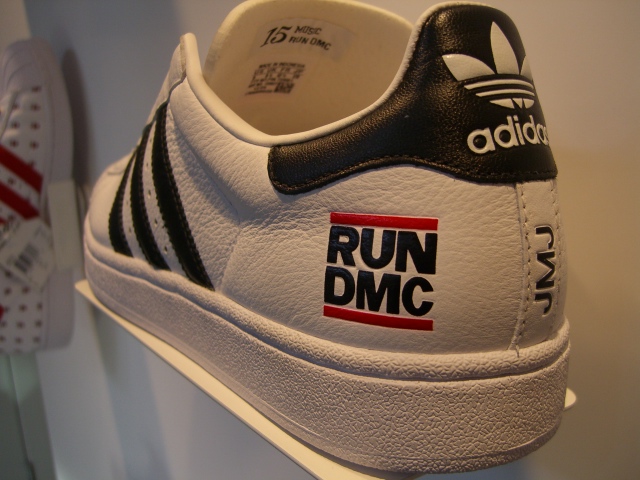Adidas: When SHACKLES Mean SHEKELS
By Tingba Muhammad
Adidas’s infamous new athletic shoe actually has a plastic anklet made to resemble a shackle, which is linked by a chain to the back of the shoe. Its design has been widely condemned as racist, but even if one were to view it entirely within the realm of sport and play, it is a design that still doesn’t make much sense. Some may remember when sneaker makers promised to make their customers “run faster and jump higher.” Instead, Adidas produced a shoe with built-in leg irons—and even though they are mock plastic ones, the concept has to be the worst possible footwear marketing idea ever.
But what makes it a verifiable race issue is that shackles have no point in the world other than to torture, imprison, and enslave—all these characteristics being the historical centerpieces of sociopathic European societies. And it is racially significant that the new shackle shoe is a basketball shoe—not soccer, not golf, not tennis—for one need only glance at the NBA finals to see that basketball is a Black man’s monopoly. One may also notice that Adidas’s shackles and chains themselves are bright orange in a prison chain-gang jumpsuit kind of way, to be marketed in a land with significantly higher incarceration rates for its dark-skinned inhabitants; hence racism must be suspected.
Of course, had they introduced a product such as the Chevy Treblinka, or the Honda Holocaust, or the Audi Auschwitz, all three companies would be history in 12 to 24 hours, all employees would be homeless, and the executives would have no chance of working in corporate America ever again. Yet this warped slavery shoe idea made it all the way up the Adidas corporate chain of command—to be fully approved by German-born CEO Herbert Hainer—and into full factory production. And just in time to be presented to the world at the 2012 Olympics in Great Britain, the greatest slave-trading nation in the history of the world.
It is a curious devolution that Adidas has made from its German origin in 1948, to this lowest point in the history of marketing. Adolf “Adi” Dassler and his brother Rudolf were raised in Germany by a shoemaking father and both entered the family business. As Hitler rose to power both brothers joined the Nazi party and, according to reports, signed their correspondences with the greeting “Heil Hitler.” There is evidence that Rudolf was a Gestapo officer. After the war the brothers feuded, and one started Adidas and the other started Puma. The fact that Adidas and Puma could exist at all in an apparel market that is as Jewish as the NBA is Black is a stunning curiosity, given the intense, high-pitched, constant Jewish whining over “black anti-Semitism”; their chasing down every surviving Nazi, like alleged concentration camp guard John Demjanjuk; and their extortion of movie star Arnold Schwarzenegger for his father’s Nazi affiliation. These Dasslers were actual Nazis, but they seem to coexist nicely with the Jewish business world when the common denominator is Mammon (Luke 16:9-13).
For Adidas, this is the second trip down this very profitable race-baiting road. The cross-over rap group of the 1980s Run D.M.C. made one of the most incredible product-placement moves in the history of modern advertising when their hit “My Adidas” applied a hip-hop swagger to Adidas’s formerly “white boy” brand. Joseph “Run” Simmons, the group’s leader, described their thinking: “They couldn’t wear shoelaces in jail and we took it as a fashion statement. The reason they couldn’t have shoelaces in jail was because they might hang themselves. That’s why [the lyric] says ‘My Adidas only bring good news and they are not used as felon shoes.’”
Well, they are “felon shoes” now—gone are the signature three stripes and the laces, and gained are the ankle chains and shackles. And though Adidas EXPLODED in popularity with this new unsolicited, uncompensated endorsement, Run D.M.C. later received a measly $1.6 million endorsement deal for putting the company at the front of a style that would “define the next 25 years of hip hop fashion.” No word yet on how many millions shackle designer Jeremy Scott will be paid for his slavery shoes that will never be sold.
The Reverend Jesse Jackson was on point: “The attempt to commercialize and make popular more than 200 years of human degradation, where blacks were considered three-fifths human by our Constitution is offensive, appalling and insensitive.”
But SHACKLES have ALWAYS meant SHEKELS (the currency of ancient Israel) in the exploitative world of retail sales. Adidas certainly has a troubling Nazi origin (for which the founders have apparently been forgiven), but far worse to Blacks is the forgotten industry that manufactured the hardware of American bondage. The bull whips, chains, steel collars, hand and foot cuffs, thumbscrews, shackles and locks, and other implements of torture and captivity, were as necessary to the white plantation owners, jailers, and slave patrollers as any other commodity. There were the slave-shipbuilders of the ports of the Northeast, but someone had to then outfit those ships with the chains and shackles needed to turn them into floating Africa/West Indies-bound dungeons.
These shipping specialists were known as ship chandlers and they had a surprising identity. According to The Secret Relationship Between Blacks and Jews, “Jews, in fact, were the largest ship chandlers in the entire Caribbean region,” the first stop for the newly kidnapped Africans. Jewish historian Seymour Liebman, agrees, and adds that the slave ships “were not only owned by Jews, but were manned by Jewish crews and sailed under the command of Jewish captains.”
Once the slave ships were “unloaded” and the kidnapped Africans were headed for the auction block, the need for chains and shackles only increased in America’s plantation economy. And here again Jewish merchants supplied that need. The little-known reality is that Jewish merchants flooded into the South during slavery. The new book Jews Selling Blacks presents hundreds of newspaper advertisements that document Jewish merchants serving every need of the slave plantation, including the auctioning of Black men, women, and children, and the pursuit and incarceration of runaway slaves. The Southern planter depended upon these merchants, “a disproportionate number of whom were Jews,” and it was they who supplied everything the plantation economy needed—including the iron shackles and chains that bound the enslaved Black man to the cruel system of forced lifelong labor. And they did not stop after “Emancipation.” Jewish merchants were shown to have supplied hoods, sheets, guns, and rope to America’s notorious terrorist group, the Ku Klux Klan.
Adidas CEO Hainer, at least, has tried to make amends: “We apologize if people are offended by the design and we are withdrawing our plans to make them available in the marketplace.” Adidas reasoned that their idea was the result of the comic book notion that the wearer would become so amazingly athletic that he would need shackles and chains to keep his shoes on. Slavery, they say, hadn’t entered into their reasoning at all.
Whatever one thinks of Adidas’s excuse, one thing is known: From slavery until today, shackles on Blacks have meant loads of shekels for American corporations, and Adidas was expecting to cash in. At $350 a pair—about the cost of “a healthy young field hand” in 1800—their slavery shoes should be the final slap of disrespect that motivates Blacks to escape the consumer plantation. Adidas has shown us that if we will not get up and DO FOR SELF—and become the sole designers, producers, and marketers of every single thing we wear—they have shoes for people who just wanna be slaves.
——–
Tingba Muhammad is a citizen of the Nation of Islam.
For more on this topic see the Nation of Islam book series The Secret Relationship Between Blacks & Jews. Download the free guide by clicking here.
To purchase the series click here.

